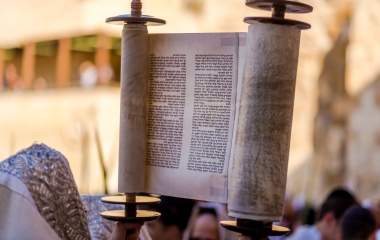
Parshat Ki Tavo opens with the mitzvot of bikkurim, the farmers’ bringing of his first fruits of the land to the Temple, and viddui maaser, the declaration of this same farmer that all tithes have been properly distributed.
On the surface these mitzvot are similar, and it is most logical that they would be juxtaposed in the Torah. Both require the farmer in the Land of Israel to acknowledge his blessings and share those blessings with others, and both require the farmer to come to Jerusalem. Almost uniquely among the mitzvot of the Torah, both require speech, specifically a declaration of compliance with the mitzvah.
And yet, when one reads the description of these mitzvot, they could not be more different. The bikkurim are brought with great joy: “And you shall rejoice with all the goodness that G-d your Lord has given you and your household, you and the Levi and the stranger who dwells amongst you” (Devarim 26:11). The Mishna describes the great fanfare and pageantry as the pilgrim farmers marched “with the flutes before them” to the Temple. "Even Agrippas the King would put the basket on his shoulder and enter [the Temple]” (Bikkurim 3:3-4). Workers would stop working to greet the pilgrims “inquiring unto their welfare[1]”.
The bikkurim were no ordinary fruit. Rather, they marked the culmination of thousands of years of Jewish history, from Yaakov’s tribulations with Lavan and our slavery and suffering in Egypt, to our redemption from Egypt and our arrival in the Land of Israel.
Farming was much more than the production of food. It was the mechanism by which we understood our link to the past, to G-d and to our fellow Jew. So central was the mitzvah of bikkurim that its text became the central text of the Pesach seder, the night we celebrate Jewish peoplehood and our special relationship with G-d.
Yet all this is missing in viddui maaser. There is no joy or fanfare, no celebration at the Temple and no historic significance attached to the mitzvah. Rather it is primarily a series of lo, no after no: “I did not violate Your commandments and I did not forget. I did not eat it as an onen (mourner before the funeral). I did not consume it while impure. I did not give it for the dead” (Devarim 26:13-14). Contrast that to bikkurim where lo, no, does not appear even once.
Even the name viddui maaser, the confession regarding the tithes, has a negative connotation, one often associated with the confession of sins we make on Yom Kippur. And unlike bikkurim, brought each year, the viddui maaser is done twice in seven years. Whereas the bikkurim focus on what G-d has done for us, viddui maaser focuses on what we have done or not done. While the concluding verse of the bikkurim begins with the word “v’samachta, and you shall rejoice,” that of viddui maaser begins with “haskeefa, look down,” a word that in Biblical Hebrew has a most negative connotation[2]—being used, for example, regarding the people of Sedom (Breisheet 18:16).
More difficult than observing these differences is explaining them. Why should mitzvot that seem so similar in purpose be presented so differently? Perhaps we can explain this as follows.
Bikkurim are the culmination of the long journey of Jewish history. After many trials and tribulations, we have reached our destination and can enjoy the fruit of the land. Excitement is in the air. We instinctively realize that we are part of a great mission, a grand vision of something greater than us. When such happens, people are all too happy to share their blessings with others. We feel fortunate and blessed and sharing those blessings is most natural. “These are the things that have no measure, haPeah vahaBikkurim” (Peah 1:1).
Precisely because we can give any amount for bikkurim we do so willingly. However, tithes have a fixed amount, one much greater than bikkurim: 2% to the kohen[3], 10% to the Levi, 10% to the poor. People often resent being told they must do something and tend to do so with much less fervour than if they were doing such voluntarily.
Furthermore, the requirement to tithe our produce is a reminder of the terrible sin of the golden calf (Seforno, Devarim 26:13). It was due to that sin that the spiritual leadership was transferred from the firstborn to the Kohanim and Levi’im. There may be an underlying resentment that we work hard, only to be forced to give so much away. We may have done “all that You have commanded me,” but it is done out of obligation, not a desire to give. The difference between maaser and bikkurim is akin to the difference between paying our taxes and supporting our favourite charity.
In reality, bikkurim and maasarot are reminders of both the arrival in the land and the transfer of leadership to the Levi’im (of which the Kohanim are a subsection). Yet the Torah presents these mitzvot in such different ways, teaching us that whether we are excited to share with others or do so only grudgingly—whether we need to give just a small amount or “give until it hurts”—share we must. It is by sharing that we “turn the attribute of anger to mercy” (Rashi, Breisheet 18:16). And mercy is something we can all use, especially as we prepare for the New Year.
[1] This is no small matter. While greeting someone is so important that Jewish law allows one to interrupt the recital of the shema to do so, worker integrity is even more crucial. Hence, Talmudic law forbids a worker from interrupting work to greet someone, viewing such as a form of theft. Yet the pageantry surrounding the bikkurim is so important that their arrival is viewed as a national holiday and hence, work is suspended.
[2] As Rashi notes—most interestingly, only in his commentary in Breisheet, but not in commenting here—only in this instance does haskeefa have a positive connotation, “for so great is the power of gifts to the poor that it turns the attribute of anger to mercy”. Nonetheless, the use of this word is striking and conjures up the negative.
[3] On a Biblical level, terumah (unlike ma’aser) has no fixed measure. Our Sages, however, recommended that one give 2% to the kohen.



